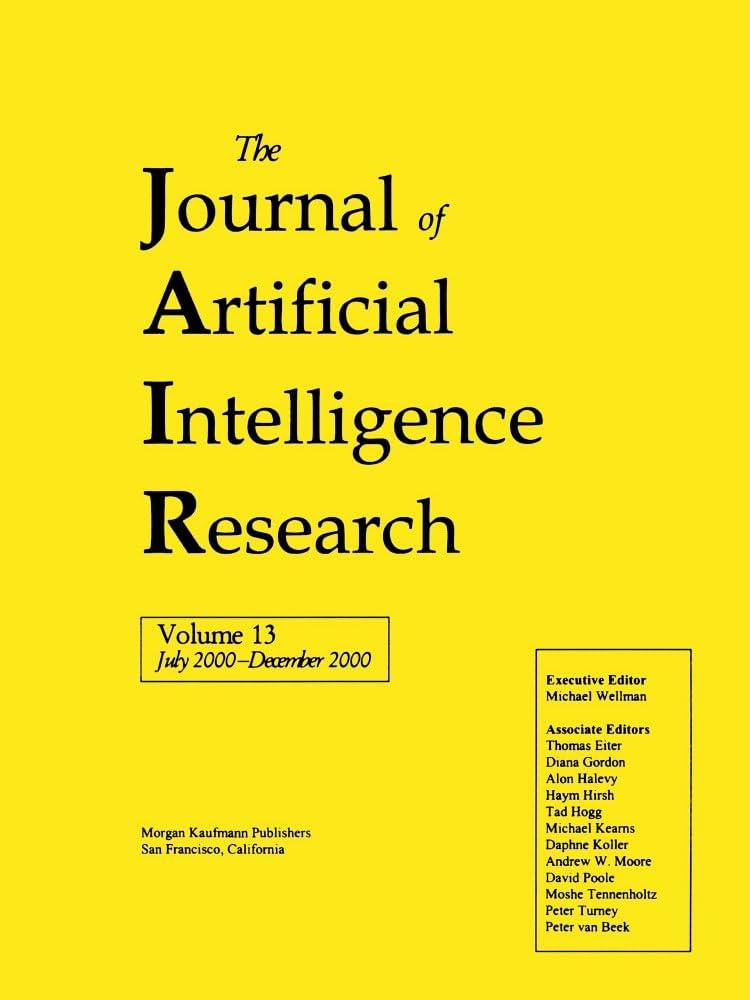Multi-Agent Path Finding: A New Boolean Encoding
IF 4
3区 计算机科学
Q2 COMPUTER SCIENCE, ARTIFICIAL INTELLIGENCE
引用次数: 2
Abstract
Multi-agent pathfinding (MAPF) is an NP-hard problem. As such, dense maps may be very hard to solve optimally. In such scenarios, compilation-based approaches, via Boolean satisfiability (SAT) and answer set programming (ASP), have been shown to outperform heuristic-search-based approaches, such as conflict-based search (CBS). In this paper, we propose a new Boolean encoding for MAPF, and show how to implement it in ASP and MaxSAT. A feature that distinguishes our encoding from existing ones is that swap and follow conflicts are encoded using binary clauses, which can be exploited by current conflict-driven clause learning (CDCL) solvers. In addition, the number of clauses used to encode swap and follow conflicts do not depend on the number of agents, allowing us to scale better. For MaxSAT, we study different ways in which we may combine the MSU3 and LSU algorithms for maximum performance. In our experimental evaluation, we used square grids, ranging from 20 x 20 to 50 x 50 cells, and warehouse maps, with a varying number of agents and obstacles. We compared against representative solvers of the state-of-the-art, including the search-based algorithm CBS, the ASP-based solver ASP-MAPF, and the branch-and-cut-and-price hybrid solver, BCP. We observe that the ASP implementation of our encoding, ASP-MAPF2 outperforms other solvers in most of our experiments. The MaxSAT implementation of our encoding, MtMS shows best performance in relatively small warehouse maps when the number of agents is large, which are the instances with closer resemblance to hard puzzle-like problems.多智能体寻径:一种新的布尔编码
多智能体寻路(MAPF)是一个np难题。因此,密集地图可能很难以最佳方式解决。在这种情况下,基于编译的方法,通过布尔可满足性(SAT)和答案集编程(ASP),已被证明优于基于启发式搜索的方法,如基于冲突的搜索(CBS)。本文提出了一种新的MAPF布尔编码方法,并给出了如何在ASP和MaxSAT中实现它。将我们的编码与现有编码区分开来的一个特征是,swap和follow冲突是使用二进制子句编码的,当前的冲突驱动子句学习(CDCL)解决方案可以利用二进制子句。此外,用于编码交换和跟踪冲突的子句的数量不依赖于代理的数量,从而允许我们更好地扩展。对于MaxSAT,我们研究了将MSU3和LSU算法结合在一起以获得最大性能的不同方法。在我们的实验评估中,我们使用方形网格,范围从20 x 20到50 x 50单元,以及仓库地图,具有不同数量的代理和障碍物。我们比较了最先进的代表性求解器,包括基于搜索的算法CBS,基于asp的求解器ASP-MAPF,以及分支-降价-价格混合求解器BCP。我们观察到我们编码的ASP实现,ASP- mapf2在我们的大多数实验中优于其他求解器。我们编码的MaxSAT实现MtMS在相对较小的仓库映射中显示出最佳性能,当代理数量很大时,这些实例更类似于困难的谜题问题。
本文章由计算机程序翻译,如有差异,请以英文原文为准。
求助全文
约1分钟内获得全文
求助全文
来源期刊

Journal of Artificial Intelligence Research
工程技术-计算机:人工智能
CiteScore
9.60
自引率
4.00%
发文量
98
审稿时长
4 months
期刊介绍:
JAIR(ISSN 1076 - 9757) covers all areas of artificial intelligence (AI), publishing refereed research articles, survey articles, and technical notes. Established in 1993 as one of the first electronic scientific journals, JAIR is indexed by INSPEC, Science Citation Index, and MathSciNet. JAIR reviews papers within approximately three months of submission and publishes accepted articles on the internet immediately upon receiving the final versions. JAIR articles are published for free distribution on the internet by the AI Access Foundation, and for purchase in bound volumes by AAAI Press.
 求助内容:
求助内容: 应助结果提醒方式:
应助结果提醒方式:


